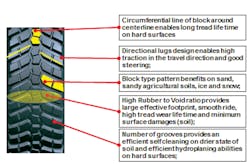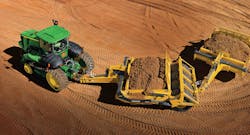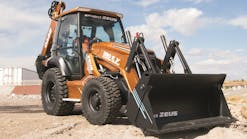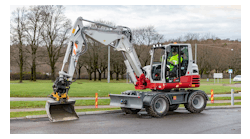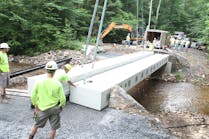Soil conditions can also dictate tread patterns. Aaron Murphy, vice president of Double Coin Tire says he hasn’t seen a lot of change in tread patterns because “what the equipment is doing hasn’t changed much.” Bruce Besancon, vice president of marketing for Alliance Tire Americas Inc. says changing the tread pattern, size, and compounds are the only things manufacturers can do; everything else is up to the operator.
Tread patterns are determined by application, states Murphy. Most common is a “multipurpose tread,” but for severe environments, a deeper, more durable tread is needed.
Soil conditions can also dictate tread patterns. Aaron Murphy, vice president of Double Coin Tire says he hasn’t seen a lot of change in tread patterns because “what the equipment is doing hasn’t changed much.” Bruce Besancon, vice president of marketing for Alliance Tire Americas Inc. says changing the tread pattern, size, and compounds are the only things manufacturers can do; everything else is up to the operator. Tread patterns are determined by application, states Murphy. Most common is a “multipurpose tread,” but for severe environments, a deeper, more durable tread is needed. [text_ad] “There are different tread patterns for different applications,” confirms Steve DePriest, sales product trainer with Hyundai Americas. “Most tires have a standard tread similar to a Michelin pattern—a middle-of-the-road tread pattern. If you need more grip, you’ll want a different style of tread.” Traditional tread patterns offer a certain amount of versatility and can usually handle rain and snow, but they don’t accommodate mud, says Jim Enyart, technical service manager for BKT USA. Working in mud requires traction, which calls for a directional pattern and lug style. “For loose or wet soil, you need an open pattern. A more open tread clears mud better. If the voids between the lugs fill with mud, you’ve got a slick.” This kind of pattern, typical on L-4 and L-5 tires, wears faster and holds heat. It’s why articulated dumps don’t drive on the road. “There are always trade-offs,” notes Enyart. Tread patterns vary widely, depending on the application. If all a large company does is road building, Enyart says by way of an example, county and state road graders will choose a specific tread pattern designed for efficiency, consistency, and adequate traction for local soils. Mini excavators are generally outfitted with a diamond pattern with rounded tread that is easy on turf. On softer soil or around office buildings or in a residential setting, more stability is needed, indicates Murphy. That means a different tread pattern. “A grader only grades one way, so you need optional traction to go one way. A loader needs traction for forward and backward; dump trucks also need traction in both directions.” A directional lug design provides “biting traction” in the travel direction, and good steering. A block pattern benefits on hard surfaces. Block-type tires are puncture-resistant and resist wear from concrete or asphalt that would grind lugs or bars into nubbins. But unless they’re designed for good self-cleaning, they will quickly turn into racing slicks in the mud. Mud calls for lugs or self-cleaning bars. A line of blocks down the centerline provides stability and durability on hard surfaces. Overlapping bar treads or block-type tires with a line of big blocks in the center deliver similar benefits, and improve ride smoothness. “High under tread” refers to a large mass of rubber beneath the tread blocks—a puncture resistance feature. This is not a good choice for transport driving at road speeds because heat builds up. Heat kills tires. Alliance’s basic 550, designed with sweeping lugs broken up into blocks, provides more edges for traction in snow. The blocks are closer together than a standard, ag-style lug tire, which provides a smoother ride and puts more rubber in contact with the ground—the rubber-to-void ratio. A high rubber-to-void ratio provides a large footprint, smooth ride, high tread wear life, and minimum surface damage. The large footprint is good for flotation and can help with traction, especially in snow or loose ground. The Solideal SKS 775 for skid-steer loaders works on hard surfaces and for severe duty applications such as road building, waste recycling, and demolition. “It has a massive 50/32nds tread depth,” says Mike Dembe, market development manager for construction North America Camoplast Solideal, “and a high lug-to-void ratio.” Incorporating hauler steps to clear out mud, it won’t bog down. The innovative tread pattern is combined with a sidewall impact guard for added protection. Another new offering for skid-steers from Solideal is the SKS 732, a premium off-road tire with massive tread depth for durability, long life, and traction. Its curved and tapered tread lug design enhances traction, and even wearing. “It has wrap-around hauler steps—a mud cleanout device,” explains Dembe. “Clean tread means higher traction.” It also features an innovative and radical side wall design. The impact guard, or “reverse sidewall,” creates a wedge to deflect material and reduce cracking. “It protects from flat tires due to sidewall impact,” says Dembe. Sidewall construction is important for machines that operate on slopes, grades, or piles of dirt because it provides stability. The trade-off, however, can be heat building and a stiff ride. A rib or street-type pattern provides a smoother ride with more mobility, suitable for finish grading, explains Besancon. The number of grooves provides efficient self-cleaning of soil.“There are different tread patterns for different applications,” confirms Steve DePriest, sales product trainer with Hyundai Americas. “Most tires have a standard tread similar to a Michelin pattern—a middle-of-the-road tread pattern. If you need more grip, you’ll want a different style of tread.”
Traditional tread patterns offer a certain amount of versatility and can usually handle rain and snow, but they don’t accommodate mud, says Jim Enyart, technical service manager for BKT USA. Working in mud requires traction, which calls for a directional pattern and lug style. “For loose or wet soil, you need an open pattern. A more open tread clears mud better. If the voids between the lugs fill with mud, you’ve got a slick.”
This kind of pattern, typical on L-4 and L-5 tires, wears faster and holds heat. It’s why articulated dumps don’t drive on the road. “There are always trade-offs,” notes Enyart.
Tread patterns vary widely, depending on the application. If all a large company does is road building, Enyart says by way of an example, county and state road graders will choose a specific tread pattern designed for efficiency, consistency, and adequate traction for local soils. Mini excavators are generally outfitted with a diamond pattern with rounded tread that is easy on turf.
On softer soil or around office buildings or in a residential setting, more stability is needed, indicates Murphy. That means a different tread pattern. “A grader only grades one way, so you need optional traction to go one way. A loader needs traction for forward and backward; dump trucks also need traction in both directions.”
A directional lug design provides “biting traction” in the travel direction, and good steering.
A block pattern benefits on hard surfaces. Block-type tires are puncture-resistant and resist wear from concrete or asphalt that would grind lugs or bars into nubbins. But unless they’re designed for good self-cleaning, they will quickly turn into racing slicks in the mud.
Mud calls for lugs or self-cleaning bars. A line of blocks down the centerline provides stability and durability on hard surfaces. Overlapping bar treads or block-type tires with a line of big blocks in the center deliver similar benefits, and improve ride smoothness.
“High under tread” refers to a large mass of rubber beneath the tread blocks—a puncture resistance feature. This is not a good choice for transport driving at road speeds because heat builds up. Heat kills tires.
Alliance’s basic 550, designed with sweeping lugs broken up into blocks, provides more edges for traction in snow. The blocks are closer together than a standard, ag-style lug tire, which provides a smoother ride and puts more rubber in contact with the ground—the rubber-to-void ratio. A high rubber-to-void ratio provides a large footprint, smooth ride, high tread wear life, and minimum surface damage. The large footprint is good for flotation and can help with traction, especially in snow or loose ground.
The Solideal SKS 775 for skid-steer loaders works on hard surfaces and for severe duty applications such as road building, waste recycling, and demolition. “It has a massive 50/32nds tread depth,” says Mike Dembe, market development manager for construction North America Camoplast Solideal, “and a high lug-to-void ratio.” Incorporating hauler steps to clear out mud, it won’t bog down. The innovative tread pattern is combined with a sidewall impact guard for added protection.
Another new offering for skid-steers from Solideal is the SKS 732, a premium off-road tire with massive tread depth for durability, long life, and traction. Its curved and tapered tread lug design enhances traction, and even wearing. “It has wrap-around hauler steps—a mud cleanout device,” explains Dembe. “Clean tread means higher traction.”
It also features an innovative and radical side wall design. The impact guard, or “reverse sidewall,” creates a wedge to deflect material and reduce cracking. “It protects from flat tires due to sidewall impact,” says Dembe. Sidewall construction is important for machines that operate on slopes, grades, or piles of dirt because it provides stability. The trade-off, however, can be heat building and a stiff ride.
A rib or street-type pattern provides a smoother ride with more mobility, suitable for finish grading, explains Besancon. The number of grooves provides efficient self-cleaning of soil.